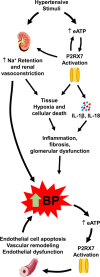P2X7 Receptors: An Untapped Target for the Management of Cardiovascular Disease
- PMID: 32998520
- PMCID: PMC7752223
- DOI: 10.1161/ATVBAHA.120.315116
P2X7 Receptors: An Untapped Target for the Management of Cardiovascular Disease
Abstract
Chronic low-grade inflammation contributes to the development of several diseases, including cardiovascular disease. Adequate strategies to target inflammation in cardiovascular disease are in their infancy and remain an avenue of great interest. The purinergic receptor P2X7 is a ubiquitously expressed receptor that predominately mediates inflammation and cellular death. P2X7 is a ligand-gated cation channel that is activated in response to high concentrations of extracellular ATP, triggering the assembly and activation of the NLRP3 (nuclear oligomerization domain like receptor family pyrin domain containing 3) inflammasome and subsequent release of proinflammatory cytokines IL (interleukin)-1β and IL-18. Increased P2X7 activation and IL-1β and IL-18 concentrations have been implicated in the development of many cardiovascular conditions including hypertension, atherosclerosis, ischemia/reperfusion injury, and heart failure. P2X7 receptor KO (knockout) mice exhibit a significant attenuation of the inflammatory response, which corresponds with reduced disease severity. P2X7 antagonism blunts blood pressure elevation in hypertension and progression of atherosclerosis in animal models. IL-1β and IL-18 inhibition has shown efficacy in clinical trials reducing major adverse cardiac events, including myocardial infarction, and heart failure. With several P2X7 antagonists available with proven safety margins, P2X7 antagonism could represent an untapped potential for therapeutic intervention in cardiovascular disorders.
Keywords: cardiovascular diseases; heart failure; infant; inflammation; interleukins.
Conflict of interest statement
None.
Figures


Similar articles
-
P2X7 receptor antagonism prevents IL-1β release from salivary epithelial cells and reduces inflammation in a mouse model of autoimmune exocrinopathy.J Biol Chem. 2017 Oct 6;292(40):16626-16637. doi: 10.1074/jbc.M117.790741. Epub 2017 Aug 10. J Biol Chem. 2017. PMID: 28798231 Free PMC article.
-
P2X7 receptor inhibition attenuated sympathetic nerve sprouting after myocardial infarction via the NLRP3/IL-1β pathway.J Cell Mol Med. 2017 Nov;21(11):2695-2710. doi: 10.1111/jcmm.13185. Epub 2017 May 4. J Cell Mol Med. 2017. PMID: 28470940 Free PMC article.
-
The purinergic 2X7 receptor participates in renal inflammation and injury induced by high-fat diet: possible role of NLRP3 inflammasome activation.J Pathol. 2013 Nov;231(3):342-53. doi: 10.1002/path.4237. Epub 2013 Sep 3. J Pathol. 2013. PMID: 23843215
-
P2X7 receptor in cardiovascular disease: The heart side.Clin Exp Pharmacol Physiol. 2019 Jun;46(6):513-526. doi: 10.1111/1440-1681.13079. Epub 2019 Apr 7. Clin Exp Pharmacol Physiol. 2019. PMID: 30834550 Review.
-
The P2X7 purinergic receptor: An emerging therapeutic target in cardiovascular diseases.Clin Chim Acta. 2018 Apr;479:196-207. doi: 10.1016/j.cca.2018.01.032. Epub 2018 Jan 31. Clin Chim Acta. 2018. PMID: 29366837 Review.
Cited by
-
Beyond Seizure Control: Treating Comorbidities in Epilepsy via Targeting of the P2X7 Receptor.Int J Mol Sci. 2022 Feb 21;23(4):2380. doi: 10.3390/ijms23042380. Int J Mol Sci. 2022. PMID: 35216493 Free PMC article. Review.
-
Ionotropic purinergic receptor 7 (P2X7) channel structure and pharmacology provides insight regarding non-nucleotide agonism.Channels (Austin). 2024 Dec;18(1):2355150. doi: 10.1080/19336950.2024.2355150. Epub 2024 May 19. Channels (Austin). 2024. PMID: 38762911 Free PMC article. Review.
-
Immunological insights into hypertension: unraveling triggers and potential therapeutic avenues.Hypertens Res. 2024 Aug;47(8):2115-2125. doi: 10.1038/s41440-024-01731-6. Epub 2024 May 22. Hypertens Res. 2024. PMID: 38778172 Review.
-
Triggering of Major Brain Disorders by Protons and ATP: The Role of ASICs and P2X Receptors.Neurosci Bull. 2023 May;39(5):845-862. doi: 10.1007/s12264-022-00986-8. Epub 2022 Nov 29. Neurosci Bull. 2023. PMID: 36445556 Free PMC article. Review.
-
Noise exposure and its relationship with postinfarction cardiac remodeling: implications for NLRP3 inflammasome activation.Bioengineered. 2022 May;13(5):12127-12140. doi: 10.1080/21655979.2022.2073126. Bioengineered. 2022. PMID: 35575239 Free PMC article.
References
-
- World Health Organization. Cardiovascular Disease. https://www.who.int/health-topics/cardiovascular-diseases/#tab=tab_1. Accessed May 28, 2020.
-
- Surprenant A, Rassendren F, Kawashima E, North RA, Buell G. The cytolytic P2Z receptor for extracellular ATP identified as a P2X receptor (P2X7). Science. 1996;272:735–738. doi: 10.1126/science.272.5262.735 - PubMed
-
- Guerra Martinez C. P2X7 receptor in cardiovascular disease: the heart side. Clin Exp Pharmacol Physiol. 2019;46:513–526. doi: 10.1111/1440-1681.13079 - PubMed
Publication types
MeSH terms
Substances
LinkOut - more resources
Full Text Sources
Other Literature Sources
Research Materials
Miscellaneous

